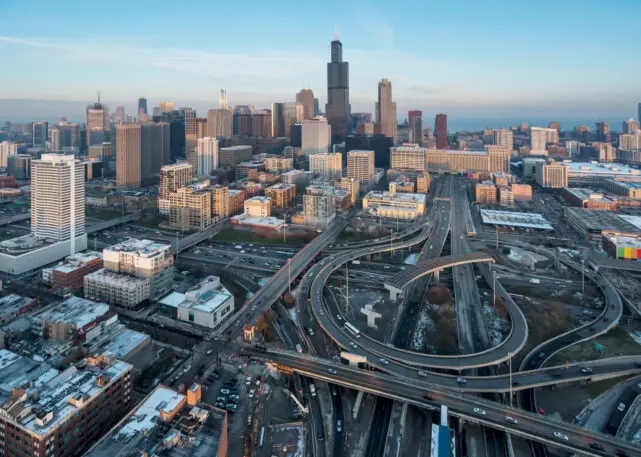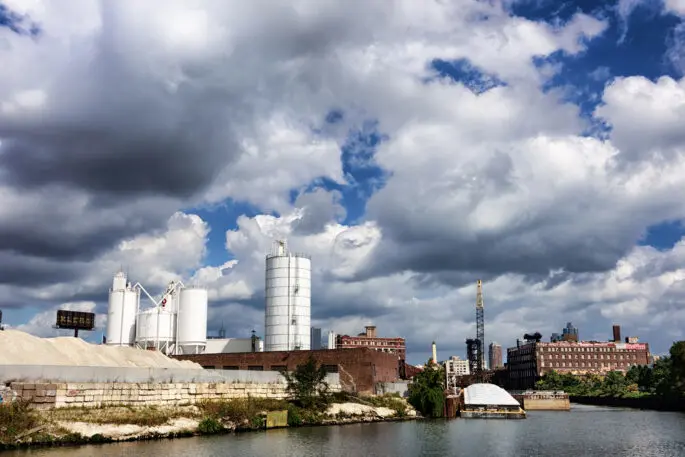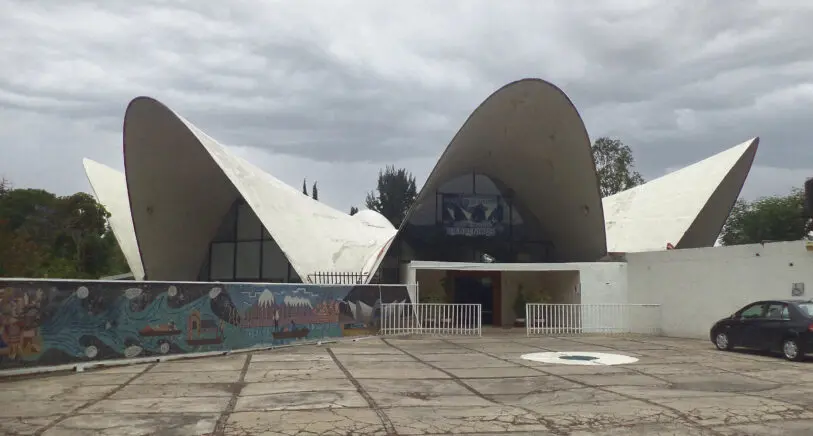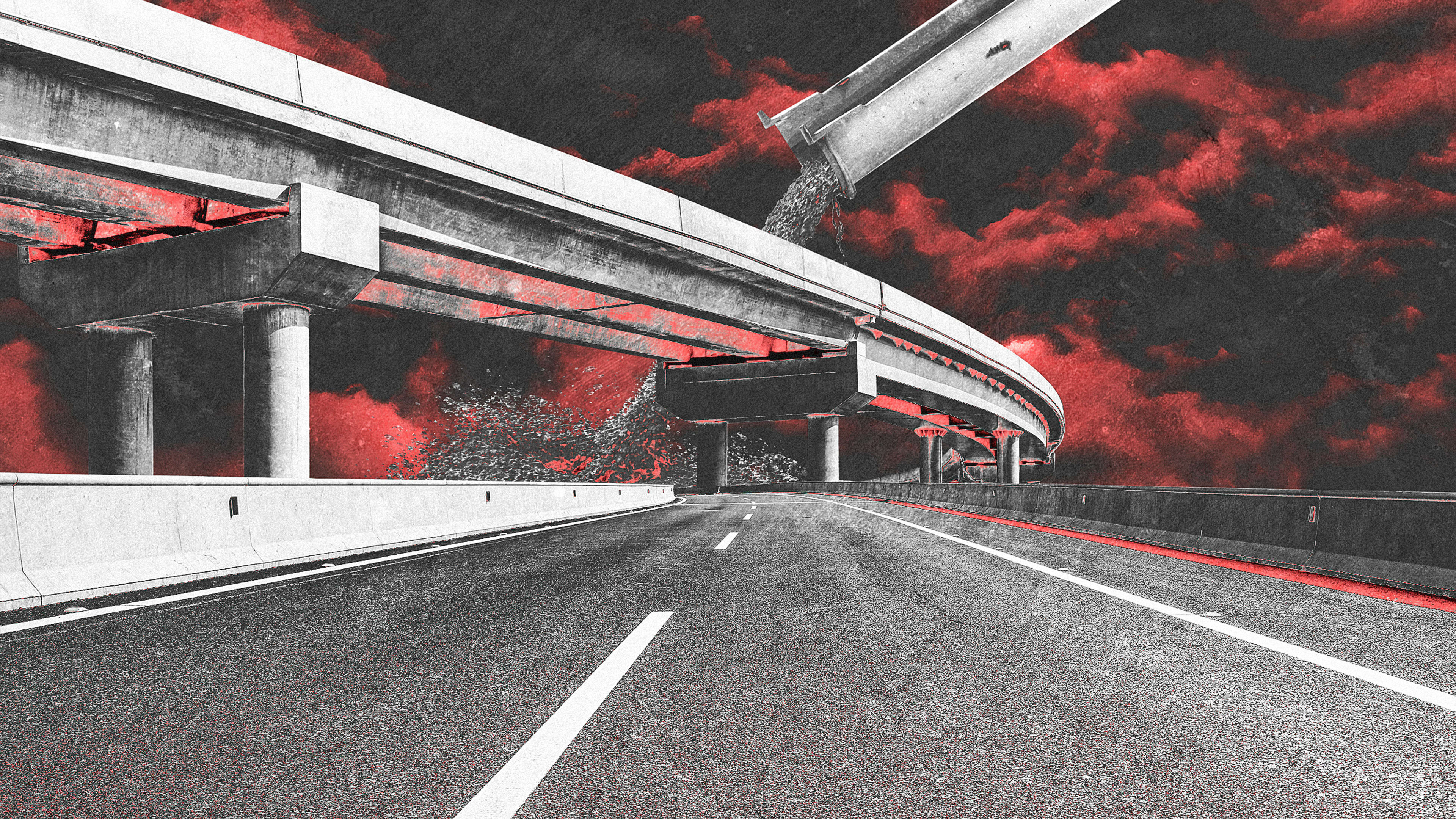If you’re reading this, chances are you are now either touching concrete or touching something that is touching concrete. By weight, the material makes up 46% of everything humans manufacture. But for most of us concrete remains hidden in plain sight: We live and work in it, step on it and drive on it, but we walk through the concrete world the way a city kid first walks through a forest. We see shape and color but don’t think much how it all connects.
Where there are people, concrete is nearly omnipresent. Where there are few or no people, concrete’s impact is also pervasive, because together concrete and cement are the world’s number two emitters of atmospheric carbon, the most prevalent greenhouse gas. Most estimates count emissions from the materials as 6% to 8% of the world total, though some estimates are up to twice that.
The huge scale of production plays a big role. Global Cement, a monthly report that’s one of the sector’s bibles, estimates that the world produces enough concrete and cement to build a city the size of Paris every week—about 33 billion tons a year. Population growth drives some of the huge volume, but a bigger driver is that modern life continually demands more concrete per person. In 1980, the per capita use of concrete was one-third of what it is today, and the U.N. expects that increased urbanization and population will drive enough construction to double the world’s collective floor space by 2060. Every manufactured ton of concrete produces .93 tons of carbon dioxide emissions.
Concrete may help fireproof us from combustible forests and provide a bulwark against rising seas but its climate effects also stir wildfires and melting ice caps, trapping us in a vicious circle: The best material for resilience necessitates more resilience against its effects. At the recently concluded COP27 climate negotiations, affluent countries were pressed to provide $100 billion a year to help poorer countries adapt to wreckage from climate change. Should the funds flow, expect thousands of miles of new concrete sea walls and other concrete bulwarks to rise in threatened zones.

One of Chicago’s most productive concrete yards sits on South Lumber Street less than 6 miles from where I live. It’s the ready-mix batch plant where the Ozinga Bros. combine mountains of raw material to make the finished roads and buildings that climb around the center of the city and fill the iconic high-rise skyline that’s visible in the distance. The city’s recent super-tall building boom has pushed the company’s concrete literally into the clouds.
I see the plant almost daily as I drive along the elevated stretch of I-55 that circles it. It feeds into the Jane Byrne interchange, a concrete monster that connects four major highways and demands drivers use every synapse to merge safely. This means that every time I drive it, I risk starring as the next collision on Waze. But I can’t resist looking down at the Ozinga plant. It’s most bewitching in the predawn twilight—those luminous white towers, full of sand, gravel and cement, the platoon of 40 or so big, red- striped, spinning barreled concrete mixer trucks lined up like circus elephants. It’s mesmerizing—a Margaret Bourke-White photo come to life.
On this day in mid-November I’m heading down to the plant. I will see the road from underneath. A nine-year, $800-million rehab of the highway is supposed to wrap up 10 days from now and the rush to finish will send nearly every truck in the yard to the job site to pour the rough equivalent of one square mile of road. That’s a close equivalent to 250 foundations for single-family homes.
I meet the first shift at 6 a.m. Men are hanging around the break room. The work’s been called off for now because there’s rain and sleet. The ice makes big trucks slip and the rain weakens the concrete. The drivers wait and share stories, like the one about a job when the ground collapsed under a truck.
Andre Calhoun, one of the plant managers, uses the down time to show me inside the towers where the raw materials are mixed and the hanging hoppers that discharge mixed concrete into the barrels of trucks that pull under them. The plant runs 24 hours a day. Mechanics are always on duty to keep the conveyors, spinning bins, and dosers from succumbing to the wrecking power of the sand, rock, and water that run through them. The gray river of wet concrete rarely stops moving.
The plant also backs up to the South Branch of the Chicago River. In the 19th century, nearly every forest in the Midwest was cut down to build Chicago, and the wood came raw and milled by barge into the city. In 1871, the Great Chicago Fire ended the wooden era as the city rebuilt using sturdier materials.

Now cement, rock and sand unload from the river into bins off Lumber Street. The Ozinga operation in Chicago’s Chinatown is one America’s highest producing city plants. It is also headquarters for a dozen or so dispatchers with headsets who stare at large monitors and route the company’s trucks through the often-choked urban maze. A wall of screens gives the dispatch center a war room feel, though the dispatchers are quiet, composed, and focused, even when squabbling with drivers who don’t like their routes.
Andre walks me to the dock and shows me a line of covered barges. The cover is a giveaway. It’s cement, the key ingredient in concrete that glues the mass together. It cannot get wet before it’s used. Andre tells me that each barge carries that same amount as 80 trucks, so the line of barges equals a few hundred trucks of material. I shake my head at the volumes. These barges, he says, came up the Mississippi from Holcim, the big Swiss materials company that is a large producer in the American Midwest and may be the world’s largest cement producer (it’s hard to know because the production stats on Chinese companies are hard to verify).
On other days, cement comes from China or Turkey. Most of the rock and sand is mined close to Chicago, and also comes into the city by barge. You can see those materials down the way, where a bucket unloader is grabbing loads and moving them to piles in the yard. The region’s system is a kind of materials superhighway, and just as with cars, it starts to look congested as you get close to downtown. I feel a bit overwhelmed.
“You can feel the city taking shape here,” I say to Andre. “There’s all this material around us, but when you look up, there’s all the bridges, roads, waterways and buildings that begin somewhere like here.”
He smiles. “A lot of people don’t see it that way,” he tells me. He says he mostly hears complaints about the noise of the trucks and the dust from the yards. You have to wonder, he says, if people know where their homes, offices and roads come from.
I’ve always known where it comes from because as far back as I can remember, I’ve been fascinated by the stuff. My architect father let me tag along on his weekend inspections of his Chicago-area job sites, and our family tourism often ended up at some concrete masterpiece, like Mexico City’s Floating Gardens of Xochimilco, where our garlanded boat happened by the thin-shelled concrete masterpiece by Félix Candela, the Los Manantiales restaurant, which sculpted the massive material into a slender, flower-like pavilion.
In my early twenties, I lived in developing Asia. Why, I wondered, was the cement magnate in Indonesia the dictator Suharto’s best friend? (Because dictators almost always keep cement and concrete magnates close. They make dictators more rich and powerful, offer a trove of contracts, jobs to hand out to cronies.)

Later, while reporting on China for my book China, Inc., it struck me how deeply the Chinese Communist Party was committed to concrete. Its top leadership linked national development to grand concrete projects and concrete-heavy urbanization. The country went into overdrive on roads, dams, airports, endless high-rise housing estates, you name it. When the Party couldn’t earn legitimacy with Communist ideology it earned it with infrastructure, and the Chinese standard of living soared. Prior to the pandemic and the current construction slowdown in China, the country produced and used more than half of the concrete produced in the world.
And when I wrote Shock of Gray, a book about global demographic change, I dug deep into causes for the doubling of the human lifespan. I came to see concrete as the world’s greatest asset for public health. It’s the material that delivers clean water, removes dirty water and builds structures that eliminate insect-borne diseases. Parasites that breed in dirt floors, for example, the world’s second-most deadly danger to children younger than 5. And now when I buy a stock or a bond, or pay my taxes, I see concrete there, too. Money in those is used to build. My new city sidewalk—financed with government debt—is in my retirement portfolio. How much of my financial life, I wonder, attaches to this tangible material. I’m working to figure that out (this is the first article in a series exploring innovation in the concrete industry), but my sense is that it’s everywhere there, too.
The materials industries, and their publicly traded peers, have come under the intense pressure from large portfolio investors to prove they are committed to lowering their impact on climate. In other words, fulfilling the criteria driven by the ESG (environmental, social, and governance) screens that are now applied to tens of trillions of dollars of capital in the hands of large investors, such as pension funds and institutional endowments. Facing public pressure and the reluctance of investors, Holcim has committed to cutting its carbon emissions by 90% by 2050 with smaller goals along the way. In other European countries and the U.S. hundreds of firms old and new are working to innovate in the construction sector.
On my way out of the plant, I follow the Interstate southwest as the highway follows another waterway, an old canal. Next to the canal, over several miles are more construction materials yards. The mounds of rock rise and fall throughout the year, but today they rise as high as I’ve seen them. A backhoe on top of one of the mounds looks minuscule. Most of the miles are construction debris hauled out of Chicago from demo’d buildings and roads. Some of it will get recycled, not as structural concrete, but as stone for gravel beds.
I suspect most people traveling the busy road don’t see the mini mountain range, or ponder its origins. The built environment can seem so static. We see a new building in a familiar spot and say, “Where did that come from?” We see an empty lot where a building we knew once stood and wonder how and when it was cleared. Concrete may seem inert, but it is the most traveled material of all. Once you see it in motion, the built world never stands still again.
A former trader and member of the Chicago Mercantile Exchange, Ted C. Fishman is the author of China, Inc. and Shock of Gray. His writing has appeared in The New York Times Magazine, Harper’s, Esquire, and many other publications. His forthcoming book on concrete will be published by W.W. Norton.
Recognize your brand’s excellence by applying to this year’s Brands That Matter Awards before the early-rate deadline, May 3.
